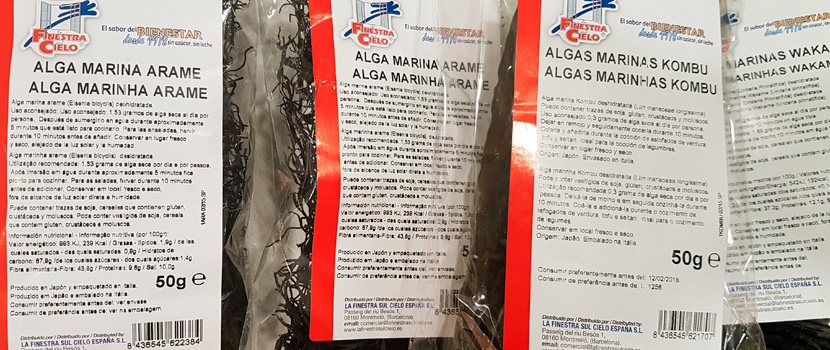Algae, the food of the future
Algae, the marine vegetables that provide us with alkalizing minerals, fiber, vitamins and more in addition to a great cleansing power for the blood and intestines.
Since ancient times there have been several coastal regions (Japan, China, Norway, the French Atlantic coast…) that regularly consume seaweed. Their habitat is the sea and they feed on its nutrients and its waters, making them special both in terms of taste and nutritional properties.
Its most outstanding minerals and properties:
• Iodine; a great purifier and activator of metabolism
• Calcium; gives strength and structure to the bones
• Magnesium; nourishes the muscles and balances the nervous system
• Potassium; Diuretics and purgatives.
• Fiber, especially soluble; helping to improve intestinal transit problems, altered intestinal flora, stomach acidity, ulcers, gastritis, cholesterol… but in addition it will help you lose weight as they are filling and provide few calories as they are low in fat and carbohydrates .
One of their great virtues that sets them apart from many other foods is their ability to capture heavy metals and toxic substances accumulated in the body thanks to their richness in chlorophyll and iodine. We cannot save ourselves from these contaminations, because we find them in rainwater as well as hygiene products, food…, being one of the important causes of health problems, especially related to the nervous system , because they accumulate among other organs in the brain, causing chronic fatigue, cognitive alterations, lack of memory, neurotransmitter imbalances, neuromuscular dysfunctions…
Thus, just a small corner of the plate where there is algae will bring us extraordinary benefits.
There are different varieties giving each a nutritional and organoleptic characteristic:
• Hiziki: Especially rich in Iron and very remineralizing. It is one of the tastiest and is therefore used a lot in cooking with character such as croquettes, bundles, cannelloni… It takes about 30 minutes to cook and its volume can increase 5 times more in dehydrated ones.
• Arame: Especially indicated for digestive and circulatory problems thanks to its natural sugars and soluble fibers. Its taste is sweeter than hiziki and its texture more tender. It is used in sautéed vegetables, in pasta, in soup… Its hydration is simply by soaking it in water for 20 minutes.
• Cochayuyo: Recommended especially for constipation, cholesterol and weight loss diets thanks to its high fiber content. It provides all the essential amino acids and is a good source of vegetable protein. Care must be taken in case of hypertension, unlike other seaweeds, because it is richer in sodium. Its taste is original, it combines the sweet and the sea with a spongy texture making it ideal for stews, creams and rice dishes. Soak it in water for 10 minutes and it will be ready for use.
• Nori: One of the richest in beta carotenes, making it ideal for improving eyesight and skin. Its taste is mild and it can be used both to make Sushi and in flakes to sprinkle on salads, rice…
• Wakame: Indicated above all to reduce hypertension and also to improve the blood condition. A sweet seaweed on the palate, gelatinous and tender texture. This is soaked for 20 minutes and can be used both in salads and creams, stir-fried vegetables, vegetable pâté… A great side dish can be sauteed Wakame with garlic, pepper and Teriyaki sauce. Once hydrated, its volume increases 10 times.
• Kombu: Especially recommended for diabetes as it helps improve blood sugar. It also softens the fibers making them more digestible and thus reducing gas and heavy digestion when consuming legumes and vegetables rich in fibers. It is a seaweed with character, both in taste and texture, being hard, cartilaginous and quite marine. Its cooking is long, being about 45 minutes on average. It is recommended to incorporate it during the cooking of legumes, broths, long stews… both to improve their digestibility and to increase the taste of these foods.
• Dulse: Indicated especially in cases of anemia as it is rich in iron and if used raw it is also rich in vitamin C (improves iron absorption). It has a good amount of beta carotene, which is beneficial for skin and vision problems. Its hydration takes 5 minutes and it can be used both raw in salads and sautéed with other foods. A good appetizer can be the dulse with spring onion, apple, endive and salad with Umeboshi vinegar vinaigrette and tahini (see previous article for Umeboshi plum)
• Sea spaghetti: It is also one of the richest seaweeds in Iron and Calcium. Its taste is mild and it simply needs to be soaked for 30 minutes. It can be used in salads, sautéed with parsley and garlic, to make vegetable pâté….
• Agar-agar: One of the most well-known and original algae. Rich in soluble fiber being beneficial in cases of constipation, high cholesterol, ulcers, intestinal inflammation… It has a transparent whitish color and a plastic-like texture that, once hydrated, is soft and gelatinous and can be used in salads. The great virtue of this seaweed is that when it is boiled, it dissolves in the liquid and once it cools it turns into gelatin. Custards, jellies, puddings, jams can be made to reduce the percentage of sugar… Simply try boiling a glass of almond milk with 1 teaspoon of agar agar powder, cinnamon and/or vanilla for 10 minutes. Leave it to cool for at least 1 hour in the fridge and you will have an almond jelly!


Leave a Reply